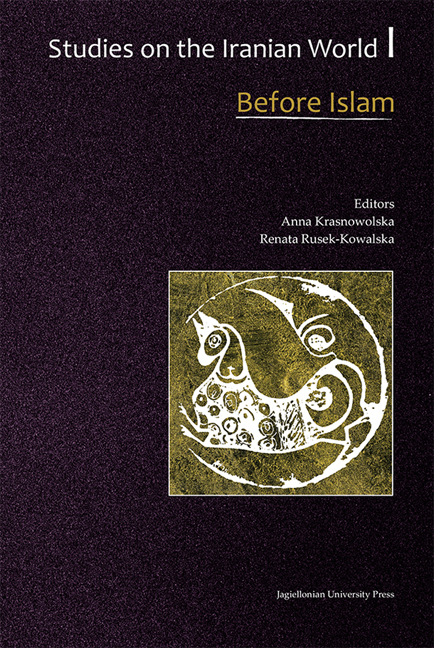Book contents
- Frontmatter
- Contents
- Foreword
- Linguistics
- Literature
- Religion
- Aspects of Hymnology in the Manichaean Community in Turfan
- Arǝdvī Sūrā Anāhitā: Considerations on the Greek ἀρχἡ
- Ohrmazd's Plan for Creation according to Book Three of the Denkard
- The Pahlavi Translation of Yašt 3
- On the Old Iranian Social Space and Its Relation to the Time Ordering System
- History
- Archaeology
The Pahlavi Translation of Yašt 3
from Religion
Published online by Cambridge University Press: 12 January 2018
- Frontmatter
- Contents
- Foreword
- Linguistics
- Literature
- Religion
- Aspects of Hymnology in the Manichaean Community in Turfan
- Arǝdvī Sūrā Anāhitā: Considerations on the Greek ἀρχἡ
- Ohrmazd's Plan for Creation according to Book Three of the Denkard
- The Pahlavi Translation of Yašt 3
- On the Old Iranian Social Space and Its Relation to the Time Ordering System
- History
- Archaeology
Summary
SUMMARY
Yt 3 is an integral part of the Xorde Avesta sensu stricto and of the daily observances, at least since the middle of the 2nd century AD. Its Avestan text is transmitted in just two main lines, the Iranian Xorde Avesta and the Indian tradition. Pahlavi translations of Yt 3 do not seem to appear earlier than the 19th century, and they are even later than the Yašts’ oldest known translation in New Persian (1706). All the translations of Yt 3 depend on the Indian transmission line, and we have reason to think that they were made in India, at a late time and on a written textual basis.
INTRODUCTION
Some recent studies have shown that in pre-Islamic times a few Yašts were intercalated parts of the so-called ‘inner ceremonies.’ While three of these Yašts have a Pahlavi Translation (PT) (Yt 1 [short and long version], 11/11a and 14), three other Yašts which never were part of the high mass have a PT, too (Yt 3, 20 and 21). Remarkably, these six Yašts with PT are the six ones with the highest frequency in XA MSS. It is obvious that the two phenomena are related to each other. But it is unclear whether all of these six translations are survivals from a Pahlavi XA of the 1st millenium AD, or whether they were produced at different times.
From a methodological point of view, the current theories dealing with the emergence of the translations of the Yašts are problematical for two reasons: 1. they argue on the basis of only a few selected examples and without any statistical data; 2. they argue on the basis of the Dhabhar edition.3 This is a problem because every edition distorts its edited texts. Geldner, for instance, edited an Avestan ‘Khorda Avesta’ which never existed. Compared with Geldner, however, the editing of a Pahlavi Xorde-Avesta is confronted with a serious problem which perhaps can be neglected in the case of the Avestan texts. The translation and even the Pahlavi translation of a Yašt exists in many cases only as several ‘translations.’ Our MSS are something between a ‘copy’ and a ‘version.’ This vulnerable non-identity is destroyed by every edition which tries to reconstruct ‘the text’ of, for instance, ‘the PT.
- Type
- Chapter
- Information
- Studies on the Iranian World: Before IslamMedieval and Modern, pp. 163 - 176Publisher: Jagiellonian University PressPrint publication year: 2015



